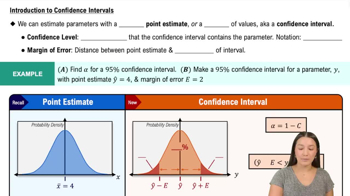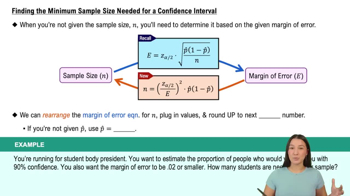You wish to estimate with confidence the population proportion of people in Gen-Z that use social media. If you want your estimate to be accurate within of the population proportion, what is the minimum sample size needed?
Table of contents
- 1. Intro to Stats and Collecting Data1h 14m
- 2. Describing Data with Tables and Graphs1h 55m
- 3. Describing Data Numerically2h 5m
- 4. Probability2h 16m
- 5. Binomial Distribution & Discrete Random Variables3h 6m
- 6. Normal Distribution and Continuous Random Variables2h 11m
- 7. Sampling Distributions & Confidence Intervals: Mean3h 23m
- Sampling Distribution of the Sample Mean and Central Limit Theorem19m
- Distribution of Sample Mean - Excel23m
- Introduction to Confidence Intervals15m
- Confidence Intervals for Population Mean1h 18m
- Determining the Minimum Sample Size Required12m
- Finding Probabilities and T Critical Values - Excel28m
- Confidence Intervals for Population Means - Excel25m
- 8. Sampling Distributions & Confidence Intervals: Proportion1h 12m
- 9. Hypothesis Testing for One Sample3h 29m
- 10. Hypothesis Testing for Two Samples4h 50m
- Two Proportions1h 13m
- Two Proportions Hypothesis Test - Excel28m
- Two Means - Unknown, Unequal Variance1h 3m
- Two Means - Unknown Variances Hypothesis Test - Excel12m
- Two Means - Unknown, Equal Variance15m
- Two Means - Unknown, Equal Variances Hypothesis Test - Excel9m
- Two Means - Known Variance12m
- Two Means - Sigma Known Hypothesis Test - Excel21m
- Two Means - Matched Pairs (Dependent Samples)42m
- Matched Pairs Hypothesis Test - Excel12m
- 11. Correlation1h 6m
- 12. Regression1h 50m
- 13. Chi-Square Tests & Goodness of Fit1h 57m
- 14. ANOVA1h 57m
8. Sampling Distributions & Confidence Intervals: Proportion
Confidence Intervals for Population Proportion
Problem 7.1.13
Textbook Question
Constructing and Interpreting Confidence Intervals. In Exercises 13–16, use the given sample data and confidence level. In each case, (a) find the best point estimate of the population proportion p; (b) identify the value of the margin of error E; (c) construct the confidence interval; (d) write a statement that correctly interprets the confidence interval.
Tennis Challenges In a recent U.S. Open tennis tournament, men playing singles matches used challenges on 240 calls made by the line judges. Among those challenges, 88 were found to be successful with the call overturned. Construct a 95% confidence interval for the proportion of successful challenges.
 Verified step by step guidance
Verified step by step guidance1
Step 1: Calculate the best point estimate of the population proportion p. The point estimate for p is given by the formula p̂ = x / n, where x is the number of successful challenges (88) and n is the total number of challenges (240). Substitute the values into the formula to find p̂.
Step 2: Compute the margin of error E. The formula for the margin of error in a confidence interval for a proportion is E = z * sqrt((p̂ * (1 - p̂)) / n), where z is the critical value corresponding to the confidence level (95% confidence level corresponds to z ≈ 1.96), p̂ is the point estimate, and n is the sample size. Substitute the values into the formula to calculate E.
Step 3: Construct the confidence interval. The confidence interval is given by the formula: CI = [p̂ - E, p̂ + E]. Use the values of p̂ and E calculated in the previous steps to construct the interval.
Step 4: Write the confidence interval in interval notation. Express the confidence interval as [lower bound, upper bound], where the lower bound is p̂ - E and the upper bound is p̂ + E.
Step 5: Interpret the confidence interval. Write a statement explaining that we are 95% confident that the true proportion of successful challenges lies within the calculated interval. Ensure the interpretation is clear and relates to the context of the problem.
 Verified video answer for a similar problem:
Verified video answer for a similar problem:This video solution was recommended by our tutors as helpful for the problem above
Video duration:
3mPlay a video:
Was this helpful?
Key Concepts
Here are the essential concepts you must grasp in order to answer the question correctly.
Point Estimate
A point estimate is a single value that serves as a best guess or approximation of a population parameter. In the context of proportions, it is calculated as the ratio of successful outcomes to the total number of trials. For example, in the tennis challenges scenario, the point estimate for the proportion of successful challenges is 88 successful calls out of 240 total challenges, which gives a point estimate of 0.3667.
Recommended video:

Introduction to Confidence Intervals
Margin of Error
The margin of error quantifies the uncertainty associated with a point estimate. It reflects how much the estimate might vary from the true population parameter and is influenced by the sample size and the confidence level. For a proportion, the margin of error can be calculated using the formula E = z * sqrt[(p(1-p)/n)], where z is the z-score corresponding to the desired confidence level, p is the point estimate, and n is the sample size.
Recommended video:

Finding the Minimum Sample Size Needed for a Confidence Interval
Confidence Interval
A confidence interval is a range of values, derived from the sample data, that is likely to contain the true population parameter with a specified level of confidence. For example, a 95% confidence interval for the proportion of successful challenges would provide a lower and upper bound around the point estimate, indicating that we can be 95% confident that the true proportion of successful challenges lies within this interval.
Recommended video:

Introduction to Confidence Intervals

 5:45m
5:45mWatch next
Master Constructing Confidence Intervals for Proportions with a bite sized video explanation from Patrick
Start learningRelated Videos
Related Practice
Multiple Choice
